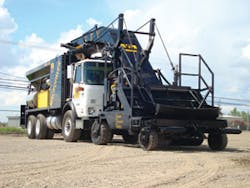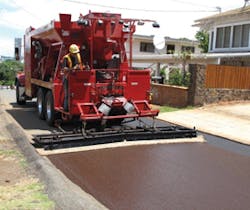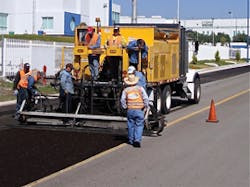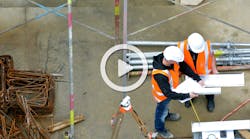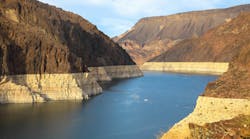Experts say that if cities want roads to last for 20 or more years, it’s important to have a consistent plan of how to treat them. From a basic standpoint, slurry seal is definitely the most economical surface treatment for residential streets, while micro surfacing is ideal for highly traveled roads. Asphalt overlays have their place, but significant money can be saved by committing to pavement preservation.
While slurry seal and micro surfacing projects most often fall into the hands of the specialty contractor rather than the typical asphalt paving contractor, more and more mainstream contractors are taking a closer look at pavement preservation methods and considering them as another tool in the arsenal. With the right approach, the right equipment, and the right expertise from emulsion suppliers, expanding one’s services to include slurry seal and micro surfacing may just be the next trend in sight.
Slurry Seal and Micro 101
As outlined by American Pavement Preservation, a Las Vegas-based contractor, the principal materials in slurry seal are latex-modified asphalt emulsion, crushed aggregate, set control additives such as Portland cement and aluminum sulfate, and water for workability. The latex-modified emulsion in the slurry seal serves as a binder, holding the crushed aggregate together and bonding the new slurry seal surface to the existing pavement. Quality slurry seal applications use latex modified asphalt emulsions.
A slurry seal for nearly any need or condition can be custom designed to satisfy the most difficult requirements. Slurry seal aggregates are graded into three main slurry seal gradations. Type 1 slurry seal is an application of one-eighth-inch-minus aggregate. Type 1 slurry seal mixtures are used for maximum crack penetration. Type 1 slurry seal is typically placed on newer streets and parking lots. Type 2 slurry seal is an application of quarter-inch-minus aggregate. Type 2 slurry seal applications are the most commonly used and are widely employed where moderate to heavy traffic conditions are found. Type 2 slurry seals are used to correct moderate to severe raveling, oxidation, and loss of matrix, and to improve skid resistance.
Type 3 slurry seal is an application of three-eighths-inch-minus aggregate. It is heavy wearing and corrects severe surface condition problems while providing skid resistance, and it can be used under heavy traffic conditions.
According to Rayner Equipment Systems, a manufacturer of road maintenance equipment, micro surfacing is a mixture that is aesthetically similar to slurry seal and is applied in almost the exact same fashion. Micro surfacing is considered a superior product to slurry seal in that it utilizes higher-quality aggregates and increased polymers in its mix designs and applications. Due to slight chemistry modifications of the micro surfacing emulsion, and the use of higher quality aggregates and increased polymers; micro surfacing can be laid in slightly thicker applications, and in multiple layers; and can be opened to traffic much faster than slurry seal. The increase in polymers and application thickness allow micro surfacing to provide an even tougher and longer lasting surface than a slurry seal.
Pavement Preservation
According to management team at American Pavement Preservation, slurry seal and/or micro surfacing each represent a philosophical change. In the past, the philosophy would be simply to remove and replace the streets with new asphalt. However, with the rising costs of asphalt materials, a new philosophy emerged-that of pavement preservation over pavement replacement.
Studies have shown that that for every dollar spent on prevention, a savings of approximately $6.00 to $10.00 on repairs and new asphalt is achieved. Not only does this reduce the overall dollars spent on street upkeep, but it has also been proven to extend the useful life of a street past its design standard of 20 years.
Eric Reimschiissel is the president of American Pavement Preservation and has been active in the slurry seal industry for more than 30 years. His company provides services and solutions for asphalt pavement maintenance, including slurry seal, seal coating, crack sealing, asphalt paving, and asphalt repairs. Reimschiissel says that southern Nevada has many requirements from city agencies that are stricter than other areas as businesses have expectations of keeping their property looking good due to the tourist industry. “The slurry seal we place here is very competitive on price, so the production rates must be high and crew capabilities must be good. We are facing tight schedules every day,” he says.
In addition, the crews must repair the streets first before applying the slurry. “Some places don’t even do the repairs of their streets before they put slurry on them,” adds Reimschiissel.
American Pavement Preservation uses Valley Slurry Seal (VSS) Macropavers to meet its production needs. “It is critical that machinery must be able to achieve high production every day and be tough enough to continue that high pace without downtime. The machine pugmills must be able to mix the materials completely and quickly to assure a good slurry seal product on the road. I chose VSS Macropavers as they are built like tanks and are very durable,” says Reimschiissel. “But most importantly, these machines will lay the amount of material I need in a fast manner, where other machines just can’t keep up with that production,” he adds.
A crew resurfaces a Honolulu road with the Roadsaver II.
Though Reimschiissel notes that his experienced crews could operate most any machine, the VSS Macropavers are very user friendly and make handling their production load a lot easier. “The crews like the fact that the machines run every day, providing them with steady work. The operators enjoy the ease of operations and the joystick controls.”
VSS Macropaver says that its Macropaver 12B offers application rates up to 4 tons per minute. The unit can apply slurry and polymer-modified micro surfacing with equal ease. A double-shaft pugmill with adjustable paddles produces a consistent pavement quality throughout the production cycle. Hydraulic fail-safe automatic sequencing-pioneered by VSS-enhances reliability while centralized monitoring systems display all material information.
Honolulu Finds Slurry Seal Success
In the recent past, Honolulu adopted slurry seal as a new road repaving technique with the understanding that it would be faster to apply, deliver greater durability, and would reduce the use of heavy equipment for paving. The Alakona Corp. won a three-year contract for the slurry seal projects, and chose the RoadSaver II manufactured by Rayner Equipment Systems. Rayner is owned by California Pavement Maintenance (CPM), a contractor with more than 35 years of slurry seal and micro-surfacing experience. The Alakona crew spent a week on the job training with CPM to familiarize itself with the equipment before the RoadSaver arrived in Hawaii. CPM also provided an expert trainer to be onsite to make certain that the equipment performed as promised.
To pour an emulsified mix from the RoadSaver II, the crew first delivers aggregate to the aggregate bin, which is designed to hold 12 cubic yards (9.2 cubic meters) and more of material. Aggregate travels on a hydraulically driven RSII SuperBelt conveyor to the reversible, twin-shaft, twin-drive pugmill. A Blackmer positive-displacement vane pump delivers the emulsion from the 60-gallon (227-liter) tank, both located at the front of the machine, to the pugmill to be mixed with the aggregate.
For mixes that require other additives, a 90-gallon (340-litre) liquid additive tank sits toward the back on the right-hand side of the machine, delivering material via a hydraulically driven pump, which is adjustable at the operator’s station. A 16-cubic-foot (0.45-cubic-meter) fines feeder sits above the aggregate bin at the back of the machine, delivering material via a digital-ratio meter, and is also adjustable at the operator’s station.
Once the materials are flowing to the pugmill at a metered and monitored rate, the multi-paddle pugmill mixes the materials and augers them out
Utah-based Intermountain Slurry Seal used a Bergkamp microsurfacing paver to resurface a 9-mile stretch of Interstate 80.
through the hydraulic gate and diverters to a spreader box, or other end attachment, at material output rates ranging from 2 tons to 4 tons mixed (1.8 to 3.6 Mg) per minute. With the automatic sequencing material introduction system, the operator can set or control which material precoats the aggregate, and for how long, before the next material enters the pugmill.
Honolulu officials reported that the slurry seal’s composition allows the repaving of a road in a single pass that will fill small cracks and voids and create a weatherproof seal. Also, the final surface improves skid resistance and handling characteristics for motorists. They also say that the slurry seal method has enabled them to maintain roads for longer periods of time, thereby reducing costs and the intervals between full-depth repaving.
Industry figures estimate that slurry seal costs up to $65,000 per lane mile. By comparison, traditional repaving methods cost $150,000 per lane mile. One California study pegged slurry seal to extend the life of road paving three to five years; however, the longevity of the slurry seal is dependent upon the condition of the road on which it’s used.
The method is billed as “green,” as cities such as Honolulu maintain that slurry seal reduces the need for heavy equipment to remove old asphalt, cuts energy used to produce hot asphalt, and requires only two vehicles to apply.
Micro Surfacing Tackles Utah Road Challenges
For several years, the Utah Department of Transportation (UDOT) was regularly forced to patch and repair a 9-mile section of I-80. Previously, the state used an open-graded surface course (OGSC) that was made up of a thin layer of hot-mix asphalt, comprised of half-inch aggregate, and provided a smooth and attractive ride for motorists. An OGSC surface treatment is designed to have very small voids so precipitation seeps through it and drains off the side of the road. This process often works well, but not in this part of Utah. Extremely cold temperatures prevented the treatment from bonding correctly to the existing asphalt overlay. Each winter, precipitation froze before getting the chance to drain and then created major potholes upon thawing. So, the UDOT looked at other surface options, one of which was micro surfacing.
Intermountain Slurry Seal, a Utah-based contractor, won the Parley’s Canyon I-80 micro-surfacing bid. The company milled the previous surface and then used the Bergkamp Inc. M1 full-size continuous micro-surfacing paver to apply two layers, or a total of 1,211,553 square yards, of Type III micro surfacing treatment.
Slurry sealing allows one-pass repaving to seal cracks and voids.
Intermountain Slurry Seal was faced with certain challenges on the project. While micro surfacing is ideal for protecting roads in the early stage of deterioration and serves as a surface treatment that extends the life of the existing asphalt, it doesn’t provide structural stability to the road. With the previous surface in such bad shape, Intermountain Slurry Seal performed a 1.5-inch mill to remove the unstable OGSC layers before applying the micro surface. A fine head mandrel with milling tools, or teeth, only a quarter-inch apart, was used to create a smooth milling surface that appeased ongoing traffic and provided a better bond between the existing asphalt and the new micro surfacing treatment.
Due to temperature fluctuations and the considerable amount of snow the Parley’s Canyon area receives, proper bonding of the new micro surface to the existing asphalt was crucial. Intermountain Slurry Seal thoroughly cleaned the surface so the pavement would adhere directly to the new treatment. Since micro surfacing adheres better in warmer temperatures, nearly all the work was completed during daytime hours, forcing the contractor to keep a concise schedule.
Half of the job included work around the watershed reservoir that supplies drinking water to area residents. All mill tailings had to be cleaned from the road each day to prevent water contamination. Micro surfacing is a green product and is environmentally safe, but letting it get into the area’s drinking water was not an option. Parley’s Canyon draws a lot of pop-up rain showers, so the crew watched the weather constantly to ensure the rain didn’t wash anything into the reservoir.
Due to environmental restrictions, all of the micro-surfacing materials had to be stored at one end of the job. Each day, the Bergkamp M1 was loaded with all necessary materials at the stockpile site. Four Bergkamp mobile support units and three Flow Boy support units were loaded with material and stationed at specific intervals in front of the continuous paver. As the paver ran out of material, a support unit slowly backed up to the paver and connected and transferred materials so it could keep running. Those support units then went back to the stockpile and refilled. This process reduced the number of construction joints or bumps in the final surface. Bergkamp’s variable width spreader box was also used to adjust to varying pavement widths and prevent overlap and gaps. Combined with a continuous paver, this makes the road smooth and consistent for easy driving.
To ensure a smooth and long-lasting surface, Intermountain Slurry Seal put the micro-surfacing treatment down in two layers. The first layer was used as a scratch coat to smooth and level the milled road. It was applied thicker at about 27 pounds per square yard. The second coat was applied (at 25 pounds per square yard) as the final driving finish to provide improved skid resistance and protection against the extreme weather conditions.
Intermountain Slurry Seal decided to add the new Bergkamp M1E Continuous Paver to its arsenal and used it to help complement the original M1 unit’s preservation of I-80. The difference between the two units is that the M1E uses the electronic mix control and diagnostic (EMCAD) system to simplify maintenance and calibration and help the owner or operator better monitor production rates and costs. Intermountain Slurry Seal grew excited about the paver’s new technology and bought it after seeing how the technology performed on other Bergkamp pavers.
Although they still liked their other units, they felt this was the direction that the industry was going.
According to Intermountain Slurry Seal, the Bergkamp M1E continuous paver machine doesn’t have any chains or sprockets, because it is all hydraulically driven, and it has cut calibration time in half. And with this new technology’s computerized monitoring system, the operator knows the percentage of each micro-surfacing mix ingredient that goes onto the roadway at all times. At any time during or after the job, the owner or contractor can request a printout of the system to determine whether the contractor is meeting the required specifications.
“The EMCAD system technology has proved to help reduce calibration by up to two-thirds,” says Bergkamp Chief Operating Officer Bill Cooper. “Through automation, owners and operators can gain information they need immediately regarding production and make changes to output levels instantly. As pavement preservation’s popularity increases globally, this technology is an excellent way to enhance performance and minimize job costs.”